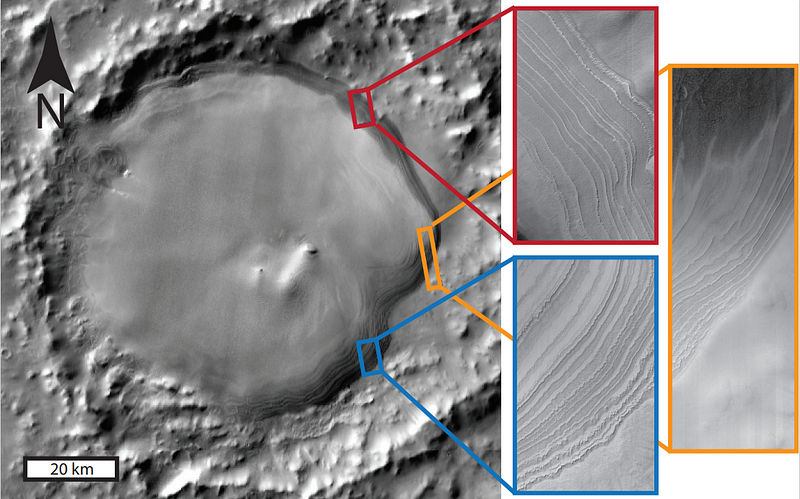Unraveling the Ice Mounds of Mars: Climate Insights Revealed
Written on
Chapter 1: The Discovery of Martian Ice Deposits
Recent investigations have uncovered layered ice deposits in craters located in Mars' southern hemisphere. These findings provide critical insights into the historical orientation of the planet, which is essential for understanding its past climate conditions. Such knowledge could potentially inform us about periods when Mars may have been suitable for life.
According to a study published in Geophysical Research Letters, lead author Michael Sori and his team analyzed the ice layers and correlated them with Mars' axial tilt. These ice formations serve as indicators of temperature, hydrological conditions, and even planetary dynamics, similar to how layered deposits on Earth reveal its climatic history.
Section 1.1: Understanding Ice Layer Patterns
The thickness of these ice layers suggests that colder temperatures were prevalent during certain periods. This correlation makes intuitive sense; thicker layers indicate extended cold phases.
Moreover, the study takes into account the precession of Mars' axis, which affects sunlight distribution on the planet's surface. As the precession shifts the axial tilt over time, various regions experience changes in sunlight exposure differently and at different times. Although this research focuses on Mars' recent history, it offers an unprecedented level of detail. Sori emphasizes the surprising clarity with which the patterns align with the planet's orbital cycles, describing it as an exceptional match.
Subsection 1.1.1: Burroughs Crater Insights

The Burroughs crater, which spans 74 kilometers and features "exceptionally well-preserved" ice layers, served as the focal point for Sori's analysis. Imagery captured by NASA's Mars Reconnaissance Orbiter's HiRISE camera allowed researchers to examine the thickness and shape of the ice layers, confirming their alignment with the planet's axial tilt and precession over the last four to five million years.
Section 1.2: Challenges of Ice Layer Analysis
It’s important to note that the study focused on younger, well-preserved ice layers. This constraint limits the ability to explore further back into Mars' climatic history, as older ice presents more complexities that can obscure clear findings. While studying older ice is possible, it lacks the precision that scientists strive for.
Chapter 2: Future Research Directions
Sori expressed optimism about future research avenues, particularly the possibility of obtaining ice cores from Mars, akin to what is done on Earth. Currently, our rovers lack the capability to perform such tasks, so researchers rely on ground-penetrating radar and high-resolution imagery for their investigations.
The video titled "Daily Space 31 March 2022: Ice Mounds Abound in Martian Craters" provides further insights into these fascinating findings and their implications for understanding Martian climate history.
Another video, "Ice Plains Of Mars (Korolev Crater)," explores the unique characteristics of Martian ice plains and how they contribute to our knowledge of the planet's climate.
More Information
For additional details, refer to the AGU press release and the study titled “Orbital Forcing of Martian Climate Revealed in a South Polar Outlier Ice Deposit” by Michael M. Sori et al., published on March 29, 2022, in Geophysical Research Letters.
This summary was crafted for the Daily Space podcast/YouTube series. For more news from Dr. Pamela Gay, Erik Madaus, and myself, please visit DailySpace.org.